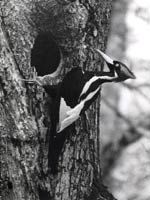
E: Environment, Enrichment,
Education, & Endangered Species
All content © by Diana L. Guerrero unless otherwise noted and may not be reprinted without prior written permission. All rights reserved. Click here for reprint permissions and fees.
The Ivory Billed Woodpecker (Campephilus principalis) is a recently rediscovered bird once thought extinct. This animal of the month was officially announced in April of 2005. To the left, an Ivory Billed Woodpecker in 1935.
Thanks to The Nature Conservancy, the Cornell Ornithology Department, and Sibley Guides for their press releases and other valuable information.
Animal of the Month
Ivory Billed Woodpecker
(Campephilus principalis)
First discovered in 1820, the Ivory Billed Woodpecker (Campephilus principalis) became a rare sight by the mid-1940's. Before the recent sightings in Arkansas (2004), the last documented sighting of an ivory-billed woodpecker in the United States was in 1944.
Unsubstantiated sightings of the bird catalyzed the dispatch of a search team in February of 2004. By February of 2005, the team reported over a dozen sightings of the species. Seven of their reports provided enough details to warrant publication in Science Express on April 28, 2005. More than 50 experts and field biologists worked together on the project.
The Ivory Billed Woodpecker is the largest of the woodpeckers north of Mexico and the third largest in the world. A pair is estimated to need at least six square miles of healthy forest habitat. Their main diet is insects (primarily beetle larvae), fruits and nuts. The birds strip bark from recently dead trees to get at the larvae.
This woodpecker has a red or red-and-black crest on the head, and a black body with large white patches in the wings. These large avians are reported to range from 46-51 cm (18-20 in) with a wingspan of 76-80 cm (30-31 in). It is not known how long they live, but experts estimate that a life span of up to 20 to 30 years may be possible.
The birds are known for their unique sound, that include a nasal tooting "kent" and a quick double knock drumming. Ornithologists (bird scientists) believe that the unique double knock (made when striking a tree with its beak) is used to establish its territory.
The woodpecker discovery has excited scientists and people from all over the world. It also catalyzed the formation of The Big Woods Conservation Partnership (April 7, 2004). The partnership works to conserve 200,000 acres of forest habitat and rivers in the Big Woods and is led by The Nature Conservancy and the Cornell Lab of Ornithology. The group also includes the University of Arkansas at Little Rock, Oakwood College in Huntsville, Alabama, Arkansas State University, Louisiana State University, the Arkansas Natural Heritage Commission, Birdman Productions, LLC, Civic Enterprises, LLC, the U.S. Fish and Wildlife Service, and the Arkansas Game and Fish Commission.
Did you know?
In the past the bills of these woodpeckers were used as decorations
by native Americans and were traded across North America. Ivory
Billed Woodpecker skulls have been found in the excavations of
archaeological sites outside of the known range of the woodpecker.
Experts suspect this shows the extent of the trade and not the
ancient range for the species.
This scientific discovery was reported and published in:
Fitzpatrick, J. W., et al. 2005. Ivory-billed Woodpecker (Campephilus
principalis) persists in continental North America. Science Express.
Jackson, J. A. 2002. Ivory-billed Woodpecker (Campephilus principalis). In The Birds of North America, No. 711 (A. Poole and F. Gill, eds.). The Academy of Natural Sciences, Philadelphia, PA.
Bird Adaptations: One specimen collected years ago measured nearly two feet long. However even when it was alive it weighed barely a pound. Birds have to be light so they can fly. Their adaptations for flight include:
- Thin, hollow bones filled with “struts,” allowing air spaces that provide strength without adding weight.
- No jawbone, no teeth, and no vertebrae in their tails.
- A reproduction system with “external eggs,” so the mother does not have to carry the weight of a developing chick. •
- Lots of neck vertebrae so they can reach objects.
- A kite-like skeleton with fewer bones than most mammals; the bones are fused together to provide support for flight.
About the columnist: Since 1978 Diana L. Guerrero has worked professionally with both wild and domestic animals. Guerrero has been affiliated with, and certified by, a variety of animal programs in the USA and Europe. Based in California, she writes, consults, and speaks. Information on her animal career programs, training courses, and her books {What Animals Can Teach Us about Spirituality (SkyLight Paths, 2003), Blessing of the Animals (Sterling, 2007), Help! My Pet is Driving Me Crazy (Guerrero Ink, 2007), Animal Disaster Preparedness for Pet Owners & Pet Professionals (Guerrero Ink, 2007)} can be found in this web site and in the shop. Questions for Guerrero should be submitted via the blog comments or membership forum.





